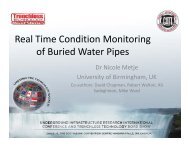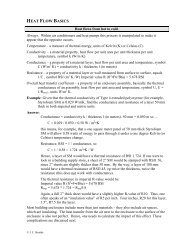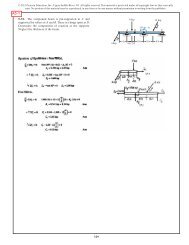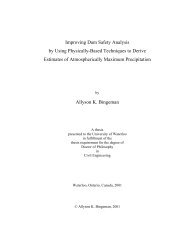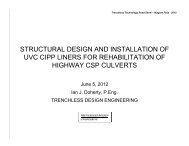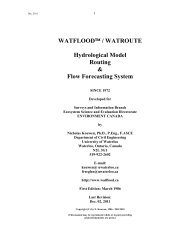Planning Horizontal Directional Drilling for Pipeline Construction
Planning Horizontal Directional Drilling for Pipeline Construction
Planning Horizontal Directional Drilling for Pipeline Construction
Create successful ePaper yourself
Turn your PDF publications into a flip-book with our unique Google optimized e-Paper software.
1.2 Description of HDD<br />
<strong>Horizontal</strong> directional drilling is a trenchless construction method utilizing<br />
equipment and techniques from horizontal oil well drilling technology and<br />
conventional road boring. HDD construction is used to install petroleum pipelines<br />
(steel or plastic), fibre optic and electric cables, and water and waste water<br />
pipelines where conventional open trench construction is not feasible or will<br />
cause adverse disturbances to environmental features, land use or physical<br />
obstacles.<br />
HDD technology is used in many situation, including the following:<br />
• lake crossings;<br />
• wetland crossings;<br />
• canal and watercourse crossings;<br />
• valley crossings;<br />
• sensitive wildlife habitat; and<br />
• road and railway crossings.<br />
HDD installation involves four main steps:<br />
1) pre-site planning;<br />
2) drilling a pilot hole;<br />
3) expanding the pilot hole by reaming; and<br />
4) pull back of pre-fabricated pipe.<br />
The following summarizes the main activities that take place during each phase of<br />
an HDD. <strong>Drilling</strong> of the pilot hole and pipe string pull back are illustrated on<br />
Figure 1.<br />
1.2.1 Pre-Site <strong>Planning</strong><br />
A determination is made as to whether an HDD is technically and geotechnically<br />
feasible by studying existing geological data and conducting field investigations<br />
to assess the subsurface conditions and characteristics likely to be encountered<br />
during the drill.<br />
If an HDD is determined to be feasible, a drill path is designed to meet the<br />
requirements of the crossing and appropriate drill entry and exit locations are<br />
selected.<br />
An allowance is made in the design of the drill path <strong>for</strong> any potential changes in<br />
the obstacle (i.e., stream migration or cutoff development) to be drilled under and<br />
the drill entry and exit points are refined.<br />
September 2004 <strong>Planning</strong> <strong>Horizontal</strong> <strong>Directional</strong> <strong>Drilling</strong> <strong>for</strong> <strong>Pipeline</strong> <strong>Construction</strong> Page 1-2




